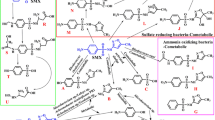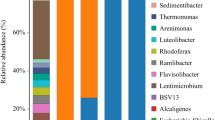Abstract
In this study, a novel strain capable of degrading sulfamethoxazole (SMX) was isolated and identified as Acinetobacter sp. The effect of influencing factors, such as initial SMX concentration (5–240 mg/L), temperature (15–35 °C), and pH (5–7), on SMX degradation was investigated. The results showed that when the initial SMX concentration was in the range of 5–240, the removal efficiency was 100%. The optimal condition for SMX biodegradation and microbial growth was determined to be 25 °C and pH = 7.0 in terms of the removal efficiencies of SMX and total organic carbon (TOC). Four metabolite compounds were detected during the process of SMX biodegradation, and the degradation pathways were tentatively proposed. In summary, Acinetobacter sp. was highly efficient in mineralizing SMX, which has the potential to be used for degrading SMX in water and wastewater.






Similar content being viewed by others
References
Blair B, Nikolaus A, Hedman C, Klaper R, Grundl T (2015) Evaluating the degradation, sorption, and negative mass balances of pharmaceuticals and personal care products during wastewater treatment. Chemosphere 134:395–401
Bouju H, Ricken B, Beffa T, Corvini PF, Kolvenbach BA (2012) Isolation of bacterial strains capable of sulfamethoxazole mineralization from an acclimated membrane bioreactor. Appl Environ Microbiol 78:5550–5558
Fischer K, Majewsky M (2014) Cometabolic degradation of organic wastewater micropollutants by activated sludge and sludge-inherent microorganisms. Appl Microbiol Biotechnol 98:6583–6597
García-Galán MJ, Díaz-Cruz MS, Barceló D (2011) Occurrence of sulfonamide residues along the Ebro river basin: removal in wastewater treatment plants and environmental impact assessment. Environ Int 37:462–473
Gibs J, Heckathorn HA, Meyer MT, Klapinski FR, Alebus M, Lippincott RL (2013) Occurrence and partitioning of antibiotic compounds found in the water column and bottom sediments from a stream receiving two wastewater treatment plant effluents in Northern New Jersey, 2008. Sci Total Environ 458–460:107–116
Herzog B, Lemmer H, Horn H, Müller E (2013) Characterization of pure cultures isolated from sulfamethoxazole-acclimated activated sludge with respect to taxonomic identification and sulfamethoxazole biodegradation potential. BMC Microbiol 13:276–285
Jiang B, Li A, Cui D, Cai R, Ma F, Wang Y (2014) Biodegradation and metabolic pathway of sulfamethoxazole by Pseudomonas psychrophila HA-4, a newly isolated cold-adapted sulfamethoxazole-degrading bacterium. Appl Microbiol Biotechnol 98:4671–4681
Karthikeyan KG, Meyer MT (2006) Occurrence of antibiotics in wastewater treatment facilities in Wisconsin, USA. Sci Total Environ 361:196–207
Kasprzyk-Hordern B, Dinsdale RM, Guwy AJ (2009) The removal of pharmaceuticals, personal care products, endocrine disruptors and illicit drugs during wastewater treatment and its impact on the quality of receiving waters. Water Res 43:363–380
Larcher S, Yargeau V (2011) Biodegradation of sulfamethoxazole by individual and mixed bacteria. Appl Microbiol Biotechnol 91:211–218
Miège C, Choubert J, Ribeiro L, Eusèbe M, Coquery M (2009) Fate of pharmaceuticals and personal care products in wastewater treatment plants—conception of a database and first results. Environ Pollut 157:1721–1726
Müller E, Schüssler W, Horn H, Lemmer H (2013) Aerobic biodegradation of the sulfonamide antibiotic sulfamethoxazole by activated sludge applied as co-substrate and sole carbon and nitrogen source. Chemosphere 92:969–978
Reis PJ, Reis AC, Ricken B, Kolvenbach BA, Manaia CM, Corvini PF, Nunes OC (2014) Biodegradation of sulfamethoxazole and other sulfonamides by Achromobacter denitrificans PR1. J Hazard Mater 280:741–749
Ricken B, Corvini PFX, Cichocka D, Parisi M, Lenz M, Wyss D, Martínezlavanchy PM, Müller JA, Shahgaldian P, Tulli LG (2004) ipso-Hydroxylation and subsequent fragmentation: a novel microbial strategy to eliminate sulfonamide antibiotics. Appl Environ Microbiol 79:5550–5558
Rohwer F, Breitbart M, Jara J, Azam F, Knowlton N (2001) Diversity of bacteria associated with the Caribbean coral Montastraea franksi. Coral Reefs 20:85–91
Wang JL, Bai ZY (2017) Fe-based catalysts for heterogeneous catalytic ozonation of emerging contaminants in water and wastewater. Chem Eng J 312:79–98
Wang JL, Chu LB (2016) Irradiation treatment of pharmaceutical and personal care products (PPCPs) in water and wastewater: an overview. Radiat Phys Chem 125:56–64
Wang JL, Wang SZ (2016) Removal of pharmaceuticals and personal care products (PPCPs) from wastewater: a review. J Environ Manag 182:620–640
Wang JL, Xu LJ (2012) Advanced oxidation processes for wastewater treatment: formation of hydroxyl radical and application. Crit Rev Environ Sci Technol 42:251–325
Wang JL, Quan XC, Han LP, Qian Y, Werner H (2002a) Microbial degradation of quinoline by immobilized cells of Burkholderia pickettii. Water Res 36:2288–2296
Wang JL, Quan XC, LB W, Qian Y, Werner H (2002b) Bioaugmentation as a tool to enhance the removal of refractory compound in coke plant wastewater. Process Biochem 38:777–781
Wang SZ, Yang Q, Zhang LN, Wang YY (2014) Kinetics of the aerobic co-metabolism of 1, 1-dichloroethylene by Achromobacter sp.: a novel benzene-grown culture. Biotechnol Lett 36:1271–1278
Xu W, Zhang G, Li X, Zou S, Li P, Hu Z, Li J (2007) Occurrence and elimination of antibiotics at four sewage treatment plants in the Pearl River Delta (PRD), South China. Water Res 41:4526–4534
Acknowledgements
This research was supported by the National Natural Science Foundation of China (51338005), the Program for Changjiang Scholars and Innovative Research Team in University (IRT-13026), and the China Postdoctoral Science Foundation (2017M610920).
Author information
Authors and Affiliations
Corresponding author
Ethics declarations
Conflict of interest
The authors declare that they have no conflict of interest.
Rights and permissions
About this article
Cite this article
Wang, S., Wang, J. Biodegradation and metabolic pathway of sulfamethoxazole by a novel strain Acinetobacter sp.. Appl Microbiol Biotechnol 102, 425–432 (2018). https://doi.org/10.1007/s00253-017-8562-4
Received:
Revised:
Accepted:
Published:
Issue Date:
DOI: https://doi.org/10.1007/s00253-017-8562-4




